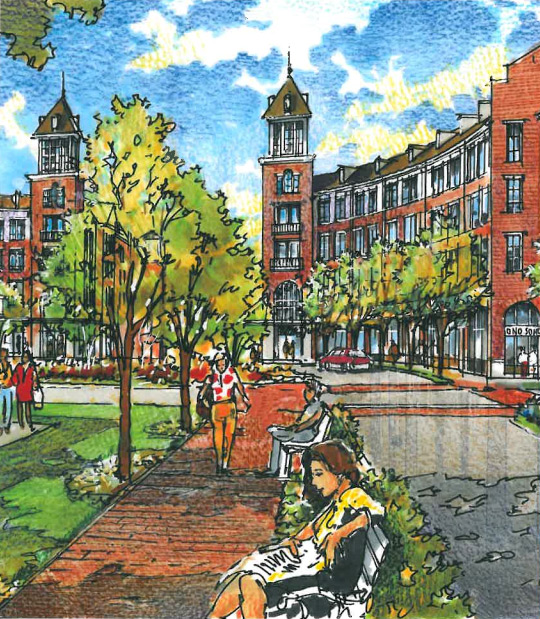
IN THIS ISSUE:
Township of West Windsor Designated a Transit Village
Ohio’s Brownfield Action Plan Pilot Program
Submetering: An Approach to Tracking Energy Expenditures
Grantee Spotlight: St. Louis Plans for Regional Renewal
Township of West Windsor Designated a Transit Village

Image courtesy of The Township of West Windsor. The Township of West Windsor, New Jersey is a community rooted in 125 years of agricultural tradition, but in recent years, this small community of 27,165 has become a hub of transportation and employment in Central New Jersey. In an effort to maintain a balance between farmland preservation and economic growth, the township is concentrating new development in compact, walkable urban centers. In 2009, West Windsor approved a redevelopment plan that includes a 350-acre mixed-use, transit-oriented village at the Princeton Junction transit station — a busy train station near Princeton University that serves 7,300 daily passengers. And in December 2011, the New Jersey Department of Transportation (NJDOT), together with nine other state agencies that make up the Transit Village Initiative interagency taskforce, designated the Township of West Windsor as the state’s 24th Transit Village.
Transit Village Initiative Promotes Smart Growth
The state of New Jersey boasts an extensive mass transit network that connects several key points along the Northeast Corridor; one in four Garden State communities is home to a rail station and 30 percent of the state’s residents live in close proximity to one. Creating dense, mixed-use developments with housing, retail, and office spaces within walking distance of transit stations not only reduces auto dependency and protects the environment, but also stimulates economic development. Since 1999, NJDOT and New Jersey Transit have promoted smart growth development throughout the state with the Transit Village Initiative.
Municipalities that show a real commitment to redeveloping areas around transit stations as compact, pedestrian-friendly, mixed-use centers are eligible to apply for the Transit Village designation. This designation enables communities to:
• Leverage more resources from the state;
• Coordinate efforts with the state agencies that make up the Transit Village task force; and
• Receive priority consideration for funding and technical assistance.
The Township of West Windsor’s Redevelopment Plan

Image courtesy of The Township of West Windsor.
West Windsor’s redevelopment plan led to the rezoning of underutilized land around the Princeton Junction Station to allow for a mix of residential, retail, and office uses. Some of the existing surface parking lots around the station will be replaced with parking decks to increase commuter parking spaces vertically, rather than spreading open lots over several acres of land. A future rapid transit bus facility and transportation infrastructure improvements to relieve congestion and expand pedestrian/bicycle access are also part of the township’s redevelopment plan. On a 25-acre parcel at the core of the redevelopment area, the plan calls for the development of 800 housing units, up to 147,500 square feet of commercial/retail space, and 50,000 square feet of public and civic spaces, including a promenade. At least 12.2 percent of housing (98 units total) will be affordable to low- and moderate-income households.
West Windsor’s redevelopment plan has drawn praise from public officials and private citizens alike. NJDOT Commissioner James Simpson said, “West Windsor’s designation is unique in that it is starting with surface parking lots and undeveloped land rather than a plan to redevelop a downtown or main street area.” He also noted that “the municipality’s vision captures all the elements of what a Transit Village should be.” West Windsor Mayor, Shing-Fu Hsueh added, “The whole idea is to promote business, mass transit, a sense of community, and reduced reliance on cars.”
The transit-oriented redevelopment plan may also reduce infrastructure and environmental maintenance costs for West Windsor in the long run. A 2009 study by the Transportation Research Board analyzed mixed-use developments — a prerequisite for Transit Village designation — and found that “an average of three out of 10 trips produced by and attracted to [mixed-used developments] put no strain on the external street network and generated very few vehicles miles traveled.” The reduced reliance on traditional infrastructure typically creates a shift toward alternative modes of transportation, as well as shifting demand trends away from single-occupancy vehicles and toward buses and rail.
The Transit Village Initiative is finding widespread support from government administrators, advocacy groups, and average citizens, as evinced by the expanding roster of Transit Village designees. There’s a growing consensus that developments supported by New Jersey’s Transit Villages Initiative are efficient and have high impact. In West Windsor, the Princeton Junction Transit Village shows that even in rural areas, there is room for smart growth.
